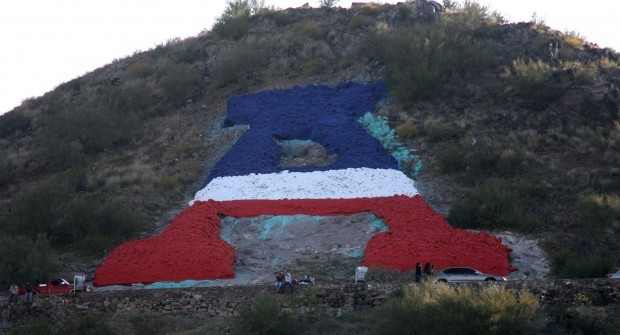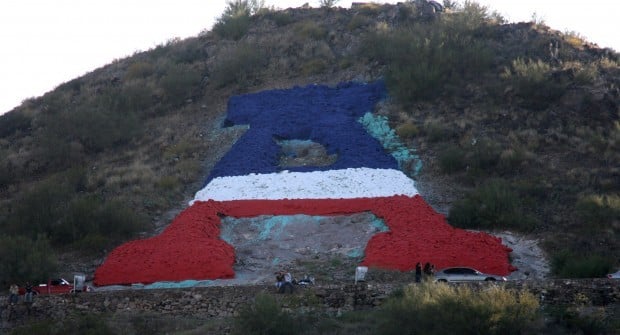While searching though microfilm of the Star to learn the fate of George Echols, who was accused of murder, the Morgue Lady discovered that claims had been made on land on Sentinel Peak.
Six years later, the U.S. Department of the Interior made the decision that the mountain belonged to Tucson.
From the Arizona Daily Star, Nov. 18, 1928:
Sentinel Peak Now
Tucson's
Every Dodson Claim Denied
'A' Day to Live Forever; City to have Recreation Spot at Its Very Doors as Result of Long Fight Before Land Office, Interior Department
By SHERRY BOWEN
"A" Mountain now belongs to Tucson.
Although the final papers have not been received here, the United States department of the interior has made the decision that ends a six-year fight, which will allow the people of Tucson to enjoy forever a recreation ground close to the city and which preserves for the University of Arizona one of its most cherished traditions.
"A" day will live on in the customs of the University and in the hearts of the men and women who all it Alma Mater. Tucson will have a rugged park on its outskirts for the use of all the people since the private claims of James R. Dodson and Christine Dodson have been overruled.
It is six years since the first stone and timber claim was filed on a portion of the mountain by Dodson, now dead, but the beginnings of that epic battle between the University of Arizona and the city of Tucson on one side and the Dodsons on the other appeared in 1916. It was in that year that students of the University, with some outside aid, constructed the giant A on Sentinel Peak and thereby changed its unofficial name to "A" mountain. That work cost more than $1000.
In that same year James R. Dodson came to Tucson. He was employed by the Warford Realty company and began to acquire information about Tucson realty values. Testimony taken in the numerous hearings on the "A" mountain case indicated that even then he was interested in the possibilities of this land as a subdivision and that he tried to interest his employers in its purchase.
In this project he failed. But he still turned envious eyes on the land which had come to be considered the natural property of the people to be used for their own pleasure. Actually the land was the property of the United States government.
Dodson Files in 1922
The next development in the fight came when Dodson filed his stone and timber claim in 1922. Then on November 15, 1923 Christine Dodson filed her claim on another section of the mountain. It was the woman's claim that covered the big "A" which had become a landmark and which was in addition, dear to the hearts of all connected to the university.
Both claims were filed with the land office at Phoenix and an agent of that office turned in a favorable report. Then Tucson aroused to action and on May 20, 1924, filed a protest against the applications. The protest was made in the name of the board of regents at the University of Arizona, the Chamber of commerce, the Woman's club of Tucson, the Rotary club, the Kiwanis club, the Lions club, Hiram club No. 2, the Tucson Merchant's association, the Business and Professional Women's club, the Pioneer Historical society, the Sunshine club, the Real Estate board and numerous other civic organizations and bodies.
The mere list is evidence that the city had awakened to the importance oif the case and was prepared for battle. The protest was heard, but the Phoenix land office held that it did not set forth facts sufficient to warrant the claims of the Dodson's being cancelled. From the text of the decision, it is evident that the office was influenced by the fact that the claimants had announced a willingness to deed to the University the tract on which the "A" had been constructed.
Morgan named attorney
There were several recourses open to the city, however, and the case was turned over to John J. Page and company of Phoenix. This firm of lawyers assigned D. B. Morgan to handle the matter. Morgan prosecuted the case vigorously with the result that he obtained a public hearing before the Phoenix land office. The hearing was granted after evidence was secured teding to indicate that the Dodsons had filed their stone and timber claim in bad faith and that the real value of the land was not in its possiblities as a quarry or as a timber tract, but as a subdivision to the city of Tucson.
This hearing resulted in a split decision. Tucson won in the Christine Dodson case involving the land where the "A" was located, but James Dodson won the judgment in his case.
Of course Tucson appealed and then the Dodsons appealed to the secretary of the interior when Tucson won its appeal. That was the final appeal and Tucson won.
Meanwhile another party had filed a mineral claim but that was also denied. The final decision states that there was no evidence to show that any prudent person would engage in mining on that claim.
A few days later, the city received a patent for "A" Mountain that included restrictions if the city wanted to keep the land. From the Star Nov. 21, 1928:
SENTINEL PEAK MUST BE PARK
City Receives Patent From President Outlining Specifications
If the city of Tucson is to retain "A" mountain, recently acquired after many months of litigation, it must be used as a public park, it was announced yesterday following the receipt of patent from President Coolidge. The patent will be revoked if it should be used for other purposes.
The patent which was received by City Auditor C. E. Pequignot, reads as follows:
"This patent is issued in accordance with provisions of the Act of Congress of June 14, 1926, and shall revert to the United States upon a finding by the secretary of the interior that for a period of five consecutive years such land has not been used by Tucson for park or recreational purposes, or that any part of the land is being devoted to other use.
(Signed) "CALVIN COOLIDGE,
"By Viola B. Prugh, Secretary."





